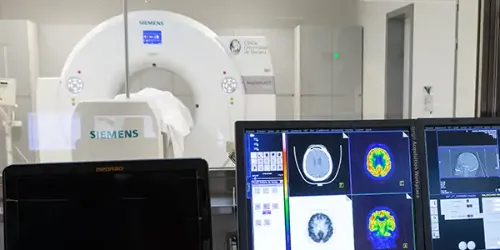Myoclonies
"In some cases they may constitute a clinical manifestation of a neurodegenerative disease".
DR. ROSARIO LUQUIN
SPECIALIST. NEUROLOGY DEPARTMENT

Myoclonies are involuntary, brief and rapid movements of varying amplitude, usually originating in the central nervous system.
They are generated by the abrupt and brief activation of a group of muscles, generating a shaking-type movement in the affected body region.
The myoclonies are similar to the tics by their short duration and abrupt beginning, but the tics in general are more stereotyped, they are preceded of a subjective sensation of urgency or necessity to make them and, in addition, they can be inhibited voluntarily during a brief time, whereas the myoclonies are not.

What are the symptoms of myoclonus?
The most common symptoms are:
- Irregular, involuntary, brief and rapid muscle twitches, which may affect a small group of muscles located in one area or body segment (focal myoclonias) or may affect different parts of the body at the same time (generalized myoclonias).
- They can appear spontaneously during rest (spontaneous myoclonias), when making a movement (action myoclonias) or appear in a reflected way before different stimuli (touch, pain, light stimulus).
- In some cases, myoclonus is not caused by muscle activation, but by short pauses in muscle activation, which causes a sudden and brief loss of postural tone. This is what is called asterixis or negative myoclonus.
Do you have any of these symptoms?
You may suffer from myoclonus
How are myoclonies diagnosed?

Once the myoclonies have been identified by exploration, it is important to take a comprehensive clinical history aimed at identifying possible triggers or related factors.
The physical and neurological examination will help in the adequate classification of the type of myoclonies and the identification of other alterations of the nervous system.
Sometimes, the realization of a neurophysiological study by expert professionals, adapted to the patient according to his clinical picture, can help in the diagnostic orientation.
Usually, it is necessary to carry out an analysis to rule out metabolic or toxic problems as well as a cerebral magnetic resonance when other causes are suspected. Faced with a possible epileptic origin, it is necessary to perform an electroencephalogram.
What are the causes?
Some myoclonies can appear under normal circumstances in healthy people, such as those that appear sometimes when we start sleeping and wake us up because of the shock, or the hiccup, which is also a form of myoclonus. They are what we call physiological myoclonies.
Other times, myoclonies can be a manifestation of a wide variety of pathological processes affecting the brain, brain stem, spinal cord or peripheral nerves.
The most frequent cause of myoclonias are metabolic encephalopathies (renal or hepatic insufficiency, ionic alterations, hypoglycemia, hyperthyroidism) and myoclonias of epileptic cause. In some cases, myoclonies can be a clinical manifestation of a neurodegenerative disease, infectious encephalopathy or deposit.
The myoclonies of epileptic cause include a wide group of syndromes that can appear at all ages, with varied expression according to the age of presentation, origin and type of crisis, which conditions the treatment and prognosis of each case.
Some commonly used medications such as some antibiotics, antidepressants, antiepileptic or antineoplastic drugs can produce myoclonus. Also poisoning by some pesticides or chemicals can produce them.
How are myoclonies treated?
Treatment will be focused first on treating the cause of the myoclonus trigger, when possible. Otherwise, we will seek a symptomatic control of them with drugs.
It is often necessary to combine several drugs for a reasonable symptomatic control of myoclonias. The most effective are drugs with antiepileptic action such as clonazepam, sodium valproate or levetirazetam.
Other medications such as piracetam or 5-hydroxytryptophan are also effective in certain types of myoclonus.
Where do we treat them?
IN NAVARRA AND MADRID
The Department of Neurology
of the Clínica Universidad de Navarra
The Neurology Department has extensive experience in the diagnosis and multidisciplinary treatment of neurological diseases.
We offer a diagnosis in less than 72 hours, along with a proposal for personalized treatment and post-consultation follow-up of the patient by our specialized nursing team.
We have the most advanced technology for an accurate diagnosis with cutting-edge equipment such as HIFU, deep brain stimulation devices, video EEG, PET and epilepsy surgery, among others.

Why at the Clinica?
- State-of-the-art diagnostic assistance with great work in research and teaching.
- Specialized nursing team.
- We work together with the Sleep Unit.

















